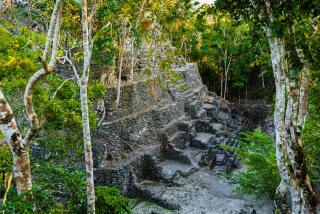The Lost Mines of Llallagua
In 1904, in the barren mountains in western Bolivia, Simon I. Patino found “La Salvadora.” It was the richest tin deposit in the world. Hard-working miners and the latest technology made Patino the “King of Tin”--one of the 10 richest men on the planet. Patino transformed a desert of stone into Llallagua, a busy city with six high schools, three theaters, two hospitals, an Olympic swimming pool, a golf course and a crowded commercial downtown. During World War II, Bolivian mines produced nearly all the tin used by Allied forces.
In 1952, a revolution took place and the tin mines, which produced 70% of Bolivia’s foreign earnings, were seized by the state. Llallagua, about 180 miles southeast of La Paz, became a city of 30,000 residents, including powerful union leaders, government bureaucrats and relatively wealthy miners and merchants.
The state’s venture, however, was an economic failure. Tin is expensive to mine and the government had not invested its earnings into new technology. Between 1979 and 1985, the state industry lost $500 million, contributing to an inflation rate that reached 24,000% in 1985. The situation became even worse when international tin prices crashed that year. Victor Paz Estenssoro--the same president who had nationalized the tin mines and who returned to office in 1985--was forced to privatize the industry and invite foreign investment. Some mines, including Llallagua, were closed. Twenty-thousand miners were fired nationwide. Llallagua’s population was halved, leaving a city of hungry phantoms.
Among them are the palliris , jucos and independent miners depicted here--an acknowledged, but largely ignored populace that resulted from Bolivia’s industrial upheaval.
Hundreds of palliris-- women scavengers--scrounge though the tailings left by the mining companies, looking for rocks with enough tin to sell to a tienda mineral --an assayer. They never had unions, salaries or social security, and they work in one of the harshest environments imaginable--at an altitude of 12,000 feet, where trees and birds can hardly exist.
Jucos are thieves who steal tin ore from the state-owned mines. Massive theft was one of the reasons the government’s industry collapsed. Theft was so lucrative that in the late ‘80s it was difficult for the university in Llallagua to hire support personnel because potential candidates made more money as jucos .
Thousands of laid-off state employees become independent miners, now working without the benefits they once enjoyed: free housing, education and health services, subsidized food and stable salaries. Independents make up 80% of Bolivia’s mining workforce, but, using technology that was already obsolete in the 19th Century, they produce less than 20% of the nation’s total mineral output.
Today, Bolivia enjoys political stability, the lowest rate of inflation in Latin America and small but steady economic growth. The benefits of these reforms have not yet reached the lives of the phantoms left behind. But new winds may be blowing over the metallic mountains of Llallagua. A Brazilian industrial giant has proposed a joint venture to work the massive tin tailings. In the mountains of Llallagua, tomorrow could be another day--if phantoms can become miners again.
More to Read
Sign up for Essential California
The most important California stories and recommendations in your inbox every morning.
You may occasionally receive promotional content from the Los Angeles Times.










